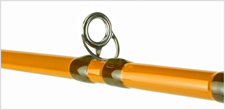| Echo Fiberglass Spey Rods | ||||
The most recent product review covered Echo’s fiberglass fly rods. A Spey rod, named the Echo Glass Two Hand, is a recent addition to the company’s lines of glass poles. All the rods are a reintroduction of fiberglass to the market. Fiberglass became out-of-favor to anglers, once graphite rods became popular. So why a fiberglass Spey? Good question, the company says. Fiberglass recovers slower than graphite, improving an angler’s feeling for loading, it says. The enhanced feedback, Echo says, is fun, for one thing. The rod features plenty of power to catapult long, heavy sink tips with ease, it says. The new rod is built to be fun and cast well, in other words.
The rods are four-piece, for transport, and feature a golden caramel finish, a classic color for glass, ceramic-ringed stripper guides, chrome snake guides and cork handles. What’s a Spey rod? Spey casting originated on Scotland’s River Spey for salmon and trout fishing with flies in the mid-1800s, according to Wikipedia. A main advantage to the cast, similar to a roll cast, is that the line is mostly kept in front of the angler, so that obstruction behind the angler, like trees, aren’t an issue. Spey casting currently is popular in fishing for salmon, steelheads and large trout with flies on large rivers. The casting also currently is used in the surf, because it’s able to punch out long casts with big flies. Watch a video on Spey casting with casting expert Steve Rajeff, who played a part in Echo’s founding, and whose company Rajeff Sports distributes Echo’s rods. The original Spey rods were 22 feet long, and Spey rods now are 12 to 15 feet, and can cast 80 feet, according to Wikipedia. Spey casting can be accomplished with a normal, one-handed fly rod, but is more common with a two-handed Spey. For more info about the Echo Glass Two Hand, visit the company’s website. |
||||
|





 Three models are available: a 12-foot 4-inch 6 weight, a 12-foot 9-inch 7 weight and a 13-foot 8 weight.
Three models are available: a 12-foot 4-inch 6 weight, a 12-foot 9-inch 7 weight and a 13-foot 8 weight.